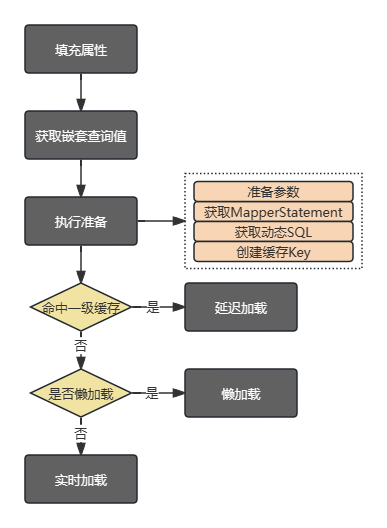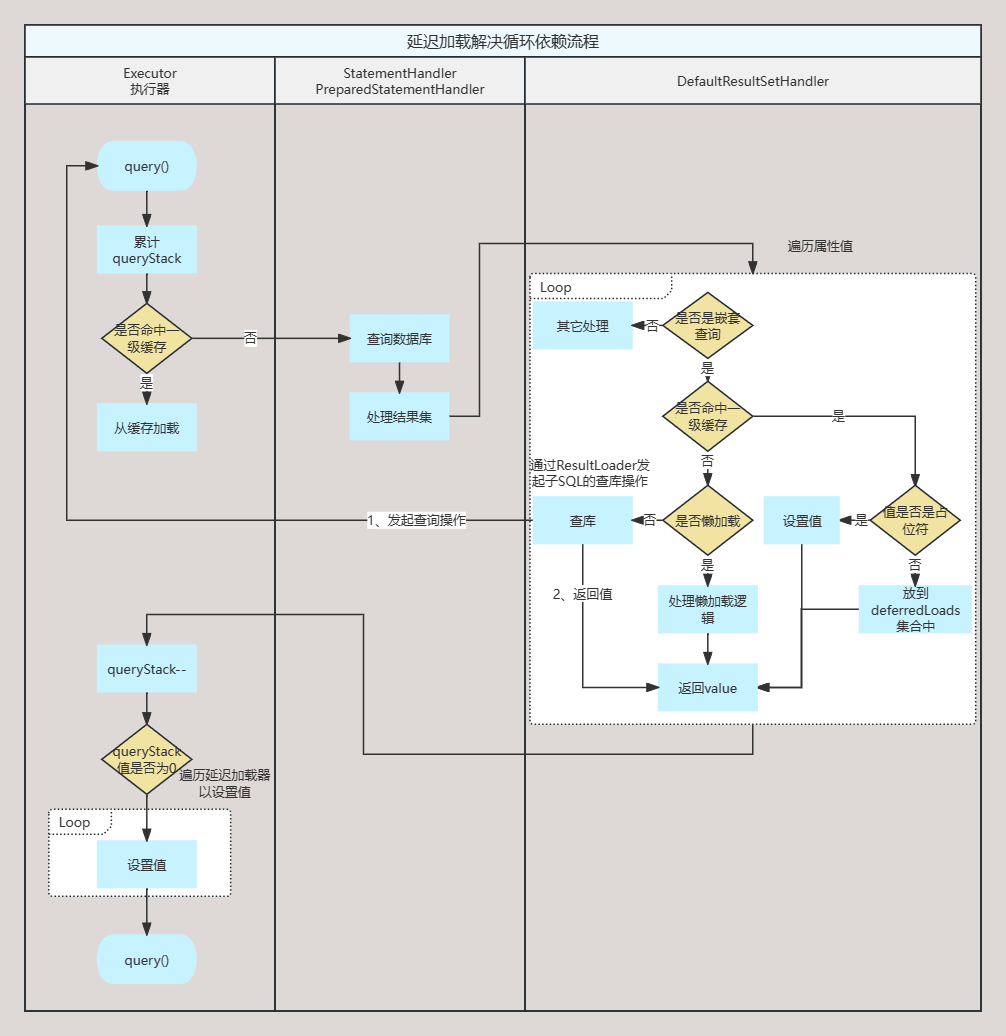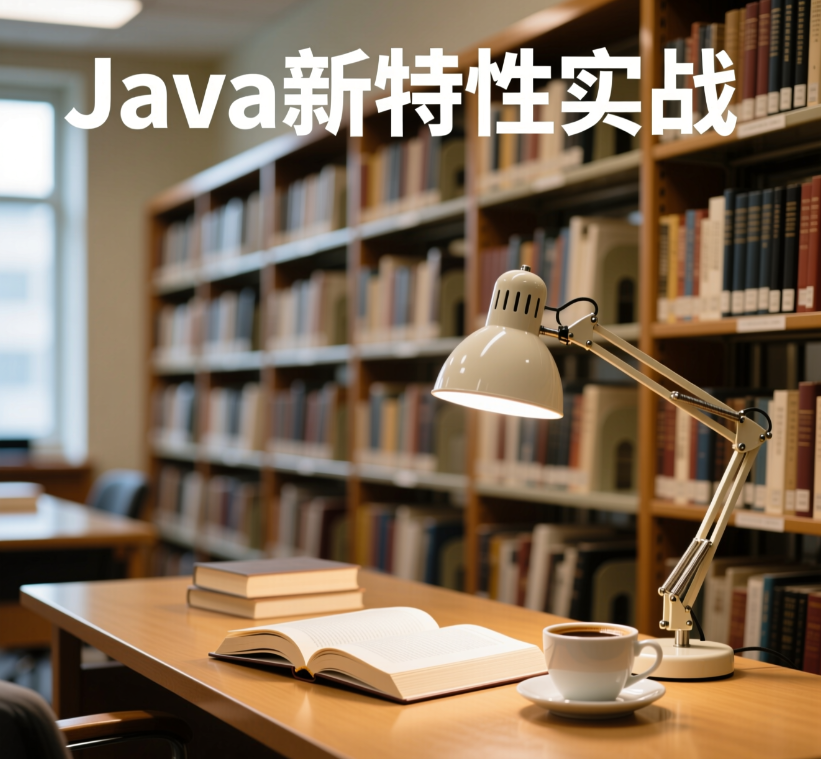A依赖B B又依赖A所构成的一种循环,也可以称为循环依赖,试想下这个场景在MyBatis中会怎样?如果不管的话那就是死循环了。
循环依赖流程

Mybatis是通过延迟加载来解决循环依赖问题的。
Demo实例
在下面例子中,BlogMap中有评论信息,而评论信息中又反过来包含博客信息,两者互相依赖。
1
2
3
4
5
6
7
8
9
10
11
12
13
14
15
16
17
18
19
20
21
22
23
24
25
26
27
| <?xml version="1.0" encoding="UTF-8"?>
<!DOCTYPE mapper PUBLIC "-//mybatis.org//DTD Mapper 3.0//EN"
"http://mybatis.org/dtd/mybatis-3-mapper.dtd">
<mapper namespace="org.example.mybatis_reader.mybatis.blog.BlogMapper">
<cache/>
<resultMap id="BlogMap" type="org.example.mybatis_reader.mybatis.blog.BlogPO" autoMapping="true">
<id column="ID" property="id" jdbcType="INTEGER"/>
<result column="TITLE" property="title" jdbcType="VARCHAR"/>
<collection property="comments" column="id" select = "selectCommentByBlogId" fetchType="eager"/>
</resultMap>
<resultMap id="commentMap" type="org.example.mybatis_reader.mybatis.blog.CommentPO" autoMapping="true" >
<id column="ID" property="id" jdbcType="INTEGER"/>
<result column="BLOG_ID" property="blogId" jdbcType="INTEGER"/>
<result column="CONTENT" property="content" jdbcType="VARCHAR"/>
<association column="BLOG_ID" property="blog" select="selectBlogById" fetchType="eager"/>
</resultMap>
<select id="selectBlogById" resultMap="BlogMap">
SELECT * FROM T_BLOG WHERE ID = #{id}
</select>
<select id="selectCommentByBlogId" resultMap="commentMap">
SELECT * FROM T_COMMENT WHERE BLOG_ID = #{id}
</select>
</mapper>
|
1
2
3
4
5
6
7
8
9
10
11
12
13
14
15
16
17
18
19
20
21
22
23
24
25
26
27
28
29
30
31
32
33
34
35
36
37
38
39
40
41
42
43
44
45
46
47
48
49
| public class BlogPO implements Serializable {
private Long id;
private String title;
private String content;
private Long userId;
private List<CommentPO> comments;
}
public class CommentPO implements Serializable {
private Long id;
private Long blogId;
private Long userId;
private String content;
private BlogPO blog;
}
|
循环依赖问题解决
先通过一张泳道图来了解下Mybatis是如何通过延迟加载机制来处理循环依赖问题的。
简单来说,Mybatis是基于一个queryStack数字、一级缓存、延迟加载器实现的解决循环依赖问题的方案。

上面一张图已经将流程描述的很清晰了,我们再简单看下每一个步骤的源码。
BaseExecutor
这段方法我们之前已经贴过很多次了,对于解决循环依赖这个场景来说,可以总结为四个步骤
- 累计queryStack
- 查询数据库或缓存
- queryStack减一
- 遍历迭代器,完成数据加载
1
2
3
4
5
6
7
8
9
10
11
12
13
14
15
16
17
18
19
20
21
22
23
24
25
26
27
28
29
30
31
32
33
34
35
36
37
38
| @Override
public <E> List<E> query(MappedStatement ms, Object parameter, RowBounds rowBounds, ResultHandler resultHandler,
CacheKey key, BoundSql boundSql) throws SQLException {
ErrorContext.instance().resource(ms.getResource()).activity("executing a query").object(ms.getId());
if (closed) {
throw new ExecutorException("Executor was closed.");
}
if (queryStack == 0 && ms.isFlushCacheRequired()) {
clearLocalCache();
}
List<E> list;
try {
queryStack++;
list = resultHandler == null ? (List<E>) localCache.getObject(key) : null;
if (list != null) {
handleLocallyCachedOutputParameters(ms, key, parameter, boundSql);
} else {
list = queryFromDatabase(ms, parameter, rowBounds, resultHandler, key, boundSql);
}
} finally {
queryStack--;
}
if (queryStack == 0) {
for (DeferredLoad deferredLoad : deferredLoads) {
deferredLoad.load();
}
deferredLoads.clear();
if (configuration.getLocalCacheScope() == LocalCacheScope.STATEMENT) {
clearLocalCache();
}
}
return list;
}
|
DefaultResultSetHandler
我们知道这个类是做结果集处理的,而且这个类的实现逻辑十分复杂,所以我们截取并分析关键流程的代码。
1
2
3
4
5
6
7
8
9
10
11
12
13
14
15
16
17
18
19
20
21
22
23
24
25
26
27
28
29
30
31
32
33
34
35
36
37
38
39
40
41
42
43
44
45
46
47
48
49
50
51
52
53
| private boolean applyPropertyMappings(ResultSetWrapper rsw, ResultMap resultMap, MetaObject metaObject,
ResultLoaderMap lazyLoader, String columnPrefix) throws SQLException {
final Set<String> mappedColumnNames = rsw.getMappedColumnNames(resultMap, columnPrefix);
boolean foundValues = false;
final List<ResultMapping> propertyMappings = resultMap.getPropertyResultMappings();
for (ResultMapping propertyMapping : propertyMappings) {
String column = prependPrefix(propertyMapping.getColumn(), columnPrefix);
if (propertyMapping.getNestedResultMapId() != null) {
column = null;
}
if (propertyMapping.isCompositeResult()
|| column != null && mappedColumnNames.contains(column.toUpperCase(Locale.ENGLISH))
|| propertyMapping.getResultSet() != null) {
Object value = getPropertyMappingValue(rsw.getResultSet(), metaObject, propertyMapping, lazyLoader,
columnPrefix);
final String property = propertyMapping.getProperty();
if (property == null) {
continue;
}
if (value == DEFERRED) {
foundValues = true;
continue;
}
if (value != null) {
foundValues = true;
}
if (value != null
|| configuration.isCallSettersOnNulls() && !metaObject.getSetterType(property).isPrimitive()) {
metaObject.setValue(property, value);
}
}
}
return foundValues;
}
private Object getPropertyMappingValue(ResultSet rs, MetaObject metaResultObject, ResultMapping propertyMapping,
ResultLoaderMap lazyLoader, String columnPrefix) throws SQLException {
if (propertyMapping.getNestedQueryId() != null) {
return getNestedQueryMappingValue(rs, metaResultObject, propertyMapping, lazyLoader, columnPrefix);
}
if (propertyMapping.getResultSet() != null) {
addPendingChildRelation(rs, metaResultObject, propertyMapping);
return DEFERRED;
} else {
final TypeHandler<?> typeHandler = propertyMapping.getTypeHandler();
final String column = prependPrefix(propertyMapping.getColumn(), columnPrefix);
return typeHandler.getResult(rs, column);
}
}
|
关键代码都维护在getNestedQueryMappingValue()中
1
2
3
4
5
6
7
8
9
10
11
12
13
14
15
16
17
18
19
20
21
22
23
24
25
26
27
28
29
30
31
32
33
34
35
36
37
38
39
40
| private Object getNestedQueryMappingValue(ResultSet rs, MetaObject metaResultObject, ResultMapping propertyMapping,
ResultLoaderMap lazyLoader, String columnPrefix) throws SQLException {
final String nestedQueryId = propertyMapping.getNestedQueryId();
final String property = propertyMapping.getProperty();
final MappedStatement nestedQuery = configuration.getMappedStatement(nestedQueryId);
final Class<?> nestedQueryParameterType = nestedQuery.getParameterMap().getType();
final Object nestedQueryParameterObject = prepareParameterForNestedQuery(rs, propertyMapping,
nestedQueryParameterType, columnPrefix);
Object value = null;
if (nestedQueryParameterObject != null) {
final BoundSql nestedBoundSql = nestedQuery.getBoundSql(nestedQueryParameterObject);
final CacheKey key = executor.createCacheKey(nestedQuery, nestedQueryParameterObject, RowBounds.DEFAULT,
nestedBoundSql);
final Class<?> targetType = propertyMapping.getJavaType();
if (executor.isCached(nestedQuery, key)) {
executor.deferLoad(nestedQuery, metaResultObject, property, key, targetType);
value = DEFERRED;
} else {
final ResultLoader resultLoader = new ResultLoader(configuration, executor, nestedQuery,
nestedQueryParameterObject, targetType, key, nestedBoundSql);
if (propertyMapping.isLazy()) {
lazyLoader.addLoader(property, metaResultObject, resultLoader);
value = DEFERRED;
} else {
value = resultLoader.loadResult();
}
}
}
return value;
}
|
最后看下延迟加载的逻辑
1
2
3
4
5
6
7
8
9
10
11
12
13
14
15
16
17
18
| protected ConcurrentLinkedQueue<DeferredLoad> deferredLoads;
@Override
public void deferLoad(MappedStatement ms, MetaObject resultObject, String property, CacheKey key,
Class<?> targetType) {
if (closed) {
throw new ExecutorException("Executor was closed.");
}
DeferredLoad deferredLoad = new DeferredLoad(resultObject, property, key, localCache, configuration, targetType);
if (deferredLoad.canLoad()) {
deferredLoad.load();
} else {
deferredLoads.add(new DeferredLoad(resultObject, property, key, localCache, configuration, targetType));
}
}
|
总结
至此,Mybatis已经解决了循环依赖问题,为了加深印象,我们再以上面的Demo描述一下整个流程。
我们假定第一个SQL为A,第二个SQL为B,整个流程为A–>B–>A
1
2
3
| SELECT * FROM T_BLOG WHERE ID = #{id}
SELECT * FROM T_COMMENT WHERE BLOG_ID = #{id}
|
A
queryStack加1,此时结果为1;
一级缓存中值为NULL,执行查库操作;
设置一级缓存,value为一个占位符;
处理结果集,发现有子查询B,拼装B需要的条件;
生成B的缓存KEY,看KEY是否在缓存中有值;此时肯定没值,也未开启懒加载,通过执行器执行B
B
queryStack加1,此时结果为2;
一级缓存中值为NULL,执行查库操作;
设置一级缓存,value为一个占位符;
处理结果集,发现有子查询A,拼装A需要的条件;
生成A的缓存KEY,看KEY是否在缓存中有值;有值,但值是一个占位符:“EXECUTION_PLACEHOLDER”,生成延迟加载对象,并放入队列(deferredLoads)中;
设置一级缓存;
queryStack减一,此时结果为1
返回处理结果;
A
再接着执行A的逻辑。设置A的一级缓存,然后queryStack减一,此时结果为0,触发延迟加载器的执行逻辑;
遍历延迟加载器并调用load()方法完成赋值;
返回处理结果;






.jpg)
.jpg)




%20(%E5%B0%8F).jpg)